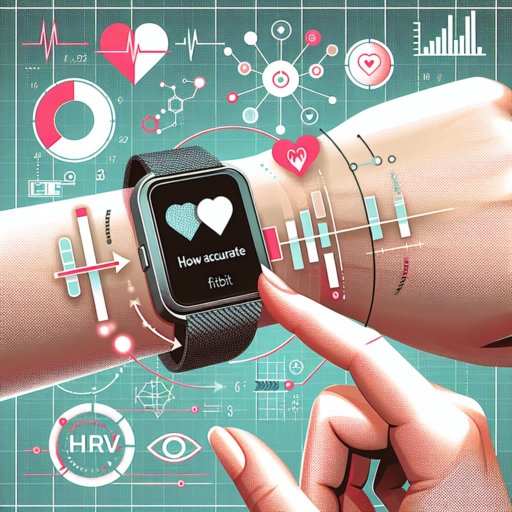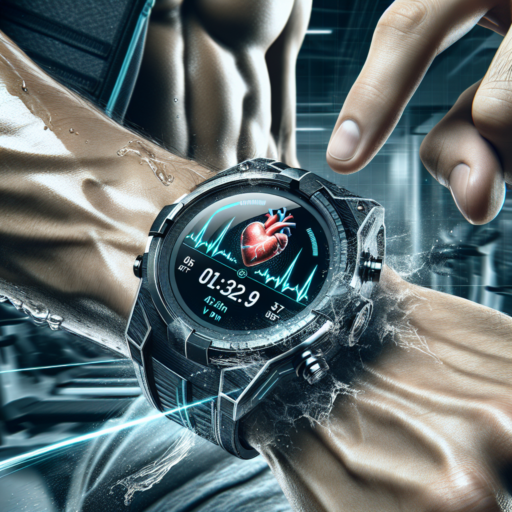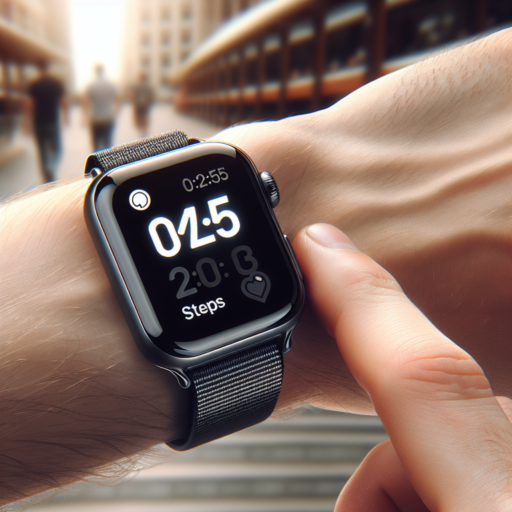Understanding Fitbit and HRV: A Comprehensive Overview
The exploration into the world of wearable technology uncovers a significant interest in devices like Fitbit, especially regarding their capabilities to monitor heart rate variability (HRV). HRV, a measure of the variation in time between each heartbeat, is widely recognized as a crucial indicator of physical fitness and stress levels. Fitbit devices, known for their sophisticated health and fitness tracking features, offer users a glimpse into their overall well-being through HRV monitoring.
HRV tracking through Fitbit devices is not just about presenting raw data; it’s about delivering insights into one’s overall health and stress management. By analyzing HRV, Fitbit provides users with vital information that can help in identifying stress patterns, understanding sleep quality, and even predicting potential health risks. This underscores the importance of HRV as a health metric and highlights Fitbit’s role in making such complex measurements accessible to the general public.
Moreover, the use of HRV data by Fitbit extends beyond mere measurement. By incorporating HRV readings into their health metrics, Fitbit devices can guide users in optimizing their workout routines, managing stress, and improving cardiovascular health. This capability of Fitbit devices to not only monitor but also interpret HRV adds a significant value to individual health management strategies, empowering users with data-driven insights to enhance their physical and mental well-being.
How Does Fitbit Measure Heart Rate Variability (HRV)?
Fitbit employs advanced technology to measure Heart Rate Variability (HRV), providing users with insights into their physical condition and recovery. The core mechanism behind measuring HRV involves analyzing the time difference between individual heartbeats. This is achieved by leveraging the optical heart rate sensor found in Fitbit devices. The sensor emits a green light that penetrates the skin, reflecting off the blood vessels. By monitoring the changes in light absorption due to the pulsating blood flow, Fitbit devices accurately capture heart rate data and consequently, HRV.
The analysis of HRV is carried out through algorithms that interpret the subtle variations in time intervals between heartbeats. These variations are influenced by the autonomic nervous system (ANS), which responds to stress, relaxation, exercise, and recovery states. HRV is a significant indicator of ANS balance and overall well-being. Fitbit’s sophisticated algorithms process this data to provide an HRV score, which is accessible to users through the Fitbit app. This score offers a non-invasive glimpse into the user’s stress levels, recovery status, and even sleep quality.
Moreover, Fitbit’s approach to measuring HRV includes continuous monitoring, which allows for the collection of ample data over different periods and conditions. This continuous tracking helps in establishing personal baselines, enabling users to observe fluctuations in their HRV scores. By observing these changes, individuals can make informed decisions about their lifestyle, exercise routines, and stress management practices.
The Accuracy of Fitbit HRV: What Research Shows
The accuracy of the Fitbit’s Heart Rate Variability (HRV) measurement has been a topic of much discussion among fitness enthusiasts and health professionals alike. HRV is a critical health metric that indicates the variation in time between each heartbeat, which is an important indicator of cardiovascular health and overall wellness. Research into the accuracy of Fitbit devices in measuring HRV provides valuable insights for users seeking to utilize these wearables to monitor their health.
Studies comparing Fitbit’s HRV measurements with those from medical-grade devices offer mixed conclusions. On one hand, several studies have found that Fitbit devices offer a reasonably accurate representation of HRV for general wellness purposes. These studies suggest that for individuals looking to monitor trends in their HRV over time, Fitbit devices provide a useful tool. On the other hand, other research highlights limitations, particularly in scenarios involving rapid fluctuations in heart rate or during high-intensity activities, where the accuracy may diminish.
It’s important for users to understand the context in which Fitbit HRV measurements are most accurate. For everyday monitoring and gaining a broad sense of one’s HRV trends, Fitbit devices can be quite effective. However, for medical or scientific purposes where precision is paramount, the consensus within the research community is to approach Fitbit’s HRV data with caution. This balance between convenience and precision highlights the need for continuous advancements in wearable technology to improve accuracy.
Comparing Fitbit HRV Accuracy with Medical Devices
When it comes to monitoring health metrics, Heart Rate Variability (HRV) has emerged as a critical indicator of stress, recovery, and overall cardiovascular health. The Fitbit brand, widely recognized for its fitness trackers and smartwatches, has incorporated HRV tracking into its devices, offering users insights into their wellbeing. However, as fitness enthusiasts and health-conscious individuals lean on this technology, questions about the accuracy of Fitbit’s HRV measurements compared to medical-grade devices come to the forefront.
Understanding HRV and Its Importance
HRV measures the variation in time between each heartbeat, which is controlled by the autonomic nervous system. It’s a window into our body’s stress levels and recovery state, making it a valuable tool for managing health and fitness. While medical-grade devices have long been the gold standard for HRV measurement, advancements in wearable technology have made this data more accessible to the everyday user. Fitbit’s approach to HRV tracking leverages sophisticated sensors and algorithms, aiming to bridge the gap between consumer convenience and medical accuracy.
Fitbit vs. Medical Devices: The Accuracy Debate
Comparing the HRV accuracy of Fitbit devices against traditional medical equipment involves examining the technology behind the measurements. Fitbits utilize photoplethysmography (PPG) sensors that measure the blood flow through the wrist to estimate HRV. In contrast, medical devices often rely on electrocardiography (ECG) for direct heart activity measurement, which is generally considered more accurate. However, Fitbit argues that their continuous monitoring feature provides a broader picture of HRV trends over time, which might offer unique insights compared to the snapshot readings from medical devices.
The ongoing dialogue between the fitness and medical communities about device accuracy underscores the importance of understanding the strengths and limitations of wearable technology. As users navigate their health journeys, recognizing that Fitbits offer an approximation rather than a precise match to medical-grade HRV measurements is crucial. This awareness allows individuals to make informed decisions about their health monitoring practices and how best to incorporate technology into their wellness routines.
Improving Your HRV: Tips and How Fitbit Can Help
Improving your Heart Rate Variability (HRV) is crucial for maintaining good cardiovascular health and overall wellness. HRV measures the variation in time between each heartbeat, which is an important indicator of your autonomic nervous system’s flexibility and your body’s ability to handle stress. Fortunately, with advancements in technology, gadgets like Fitbit are becoming invaluable tools in monitoring and enhancing HRV. Here are some strategies and insights into how Fitbit can assist in this process.
Understand Your Baseline with Fitbit
Before you embark on improving your HRV, it’s essential to know your current state. Fitbit provides detailed analytics that help you understand your baseline HRV. By consistently wearing your Fitbit, especially during sleep, it tracks your HRV trends over time. This data is crucial in identifying patterns and the impact of lifestyle changes on your HRV. Knowing your baseline allows you to set realistic goals and measure progress accurately.
Incorporate Targeted Exercise Routines
Exercise is a pillar of improving HRV, but not all exercises impact HRV similarly. Using the insights from your Fitbit, you can start to incorporate more HRV-friendly workouts into your routine. Activities like yoga, moderate aerobic exercise, and strength training, when done regularly, can enhance your HRV. Fitbit also offers personalized exercise recommendations based on your current fitness levels, ensuring you’re not over or under-training, which can be detrimental to your HRV improvement efforts.
Prioritize Stress Management and Recovery
Stress is a significant factor affecting HRV. High levels of stress can lead to lower HRV, indicating poor autonomic balance and resilience. Your Fitbit can help monitor stress levels through various metrics, including HRV scores. By recognizing patterns of stress and recovery, you can take proactive steps in managing stress, such as engaging in mindfulness practices, improving sleep quality, and employing breathing exercises. Fitbit’s guided breathing sessions can be particularly beneficial in facilitating relaxation and enhancing HRV over time.
No se han encontrado productos.
The Impact of Daily Activities on Fitbit HRV Readings
Understanding the impact of daily activities on Fitbit Heart Rate Variability (HRV) readings is crucial for anyone looking to optimize their health and fitness routine. HRV measures the variation in time between each heartbeat, which is closely tied to our body’s autonomic nervous system and overall stress levels. Engaging in various daily activities, whether it’s a strenuous workout, a stressful meeting, or even sound sleep, can significantly influence these readings, offering valuable insights into our well-being.
One key aspect is the influence of physical exercise on HRV. Moderate to high-intensity workouts can initially lower HRV, reflecting the body’s increased stress and effort. However, regular exercise tends to improve resting HRV over time, indicating better cardiovascular fitness and lower stress levels. It’s crucial to monitor these changes through your Fitbit, as it can help tailor your workout plans for optimal health benefits.
Another significant impact comes from mental and emotional stress. High-stress levels, whether from work, personal life, or even lack of sleep, can lead to a decrease in HRV. This reduction signals that the body is under stress, operating in a ‘fight or flight’ mode more frequently than is healthy. Activities like meditation, deep-breathing exercises, and ensuring adequate sleep can help mitigate this effect, improving your HRV readings. Your Fitbit can be a valuable tool in tracking these patterns and encouraging habits that foster relaxation and recovery.
How to Interpret Your Fitbit HRV Scores for Better Health
Understanding your Fitbit HRV (Heart Rate Variability) scores is crucial in monitoring your overall wellness and fitness progress. Heart Rate Variability measures the variation in time between each heartbeat, which is an indicator of your autonomic nervous system’s flexibility. A higher HRV suggests a healthier heart and a body that is better at managing stress. Conversely, a lower HRV could indicate stress, overtraining, or potential health issues.
When aiming for better health, it’s important to note that HRV scores can fluctuate based on a variety of factors, including physical activity, stress, sleep quality, and even your hydration levels. To accurately interpret your Fitbit HRV scores, start by observing your baseline HRV value. This requires monitoring your scores over a period of time — ideally, a few weeks — to understand what’s normal for you. Subsequent readings can then be evaluated in the context of this baseline to identify significant changes or trends.
What to Look For in Your HRV Trend
Significant changes in your HRV trends can be indicative of how your lifestyle is impacting your autonomic nervous system and overall health. An increasing HRV trend over time often suggests improvements in fitness levels, stress management, and recovery rates. On the other hand, a decreasing HRV trend may warrant a closer look at potential stressors or health issues that may be affecting you. It’s key to observe these trends relative to your own baseline rather than comparing with others, as individual HRV scores can vary greatly based on genetics and personal health history.
Lastly, integrating other data from your Fitbit, such as steps taken, sleep quality, and resting heart rate, with your HRV scores, will provide a more comprehensive view of your health. This holistic approach allows for better interpretation and understanding of what your body is telling you through your HRV scores and how you can adjust your lifestyle for better health outcomes.
User Experiences: Testimonials on Fitbit HRV Accuracy
The accuracy of Fitbit in measuring Heart Rate Variability (HRV) has been a subject of great interest for both fitness enthusiasts and health-conscious individuals. As wearable technology continues to evolve, Fitbit has become a staple in the wellness community, offering insights into various aspects of physical health. Through user testimonials, we gain invaluable perspectives on how Fitbit’s HRV measurements stand up to real-world use.
Many users have turned to Fitbit to monitor their HRV as a means of understanding stress levels, recovery status, and overall heart health. Testimonials often highlight the convenience and user-friendly nature of Fitbit devices, making daily health monitoring an accessible task for many. Users have praised how Fitbit HRV readings have helped them make lifestyle adjustments, including improved sleep habits, more mindful relaxation techniques, and targeted exercise routines.
Challenges and limitations in HRV accuracy have also been a topic of discussion among Fitbit users. While some testimonials reflect satisfaction with the device’s performance, others point out discrepancies when comparing Fitbit readings to other medical-grade monitors. Despite this, the majority of users agree that for non-professional purposes, the Fitbit offers a good approximation of HRV that can beneficially impact health management practices.
Software Updates and Their Impact on Fitbit HRV Precision
Software updates play a crucial role in the performance and functionality of wearable technology, including the precision of HRV (Heart Rate Variability) tracking on Fitbit devices. As developers continually refine algorithms and add new features, users often notice significant improvements in how their devices capture and interpret HRV data. This evolution underscores the importance of staying current with software updates to harness the full potential of Fitbit’s HRV tracking capabilities.
One notable aspect of software updates is the enhancement of HRV accuracy. Through the integration of advanced algorithmic updates, Fitbit devices can offer more precise HRV readings. This precision is vital for users who rely on HRV data to monitor stress, recovery, and overall wellness. The improvements in algorithm efficiency not only refine the data collected but also ensure that users have access to insights that can influence lifestyle and health decisions in real time.
Beyond improving accuracy, software updates often introduce new functionalities related to HRV measurements. Features such as detailed sleep analysis, stress management scores, and better integration with health apps expand the utility of HRV data, providing a more comprehensive view of the user’s health and fitness. By implementing these updates, Fitbit strives to offer a holistic health monitoring experience that goes beyond simple step counting, elevating the role of HRV in everyday wellness and activity tracking.
Frequently Asked Questions (FAQs) About Fitbit HRV Accuracy
Understanding the accuracy of Fitbit’s Heart Rate Variability (HRV) measurements is essential for those utilizing this feature to monitor their health and fitness. As wearable technology continues to evolve, Fitbit has made strides in providing its users with reliable data to support a proactive lifestyle.
How Accurate Is Fitbit’s HRV Measurement?
Fitbit’s HRV algorithms are designed to offer a snapshot of your autonomic nervous system by analyzing the time variation between heartbeats. While these measurements provide valuable insights, it’s important to recognize that factors like placement of the device, movement, and even hydration can impact the accuracy. However, Fitbit continually updates its algorithms to enhance precision, making it a trusted tool for many in tracking their overall well-being.
Can Fitbit HRV Data Be Compared To Clinical Measurements?
When comparing Fitbit’s HRV data to clinical measurements, it’s crucial to acknowledge the difference in methodologies. Fitbit devices are engineered for everyday use, providing an accessible way to monitor trends over time. Although not a substitute for clinical instrumentation, Fitbit’s HRV metrics can serve as a beneficial indicator of your health patterns, offering insights that help in making conscious lifestyle choices.
No se han encontrado productos.




